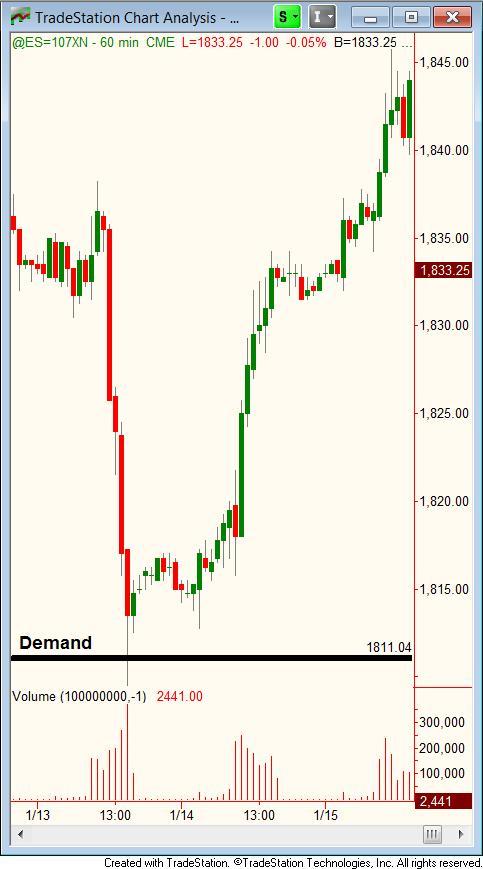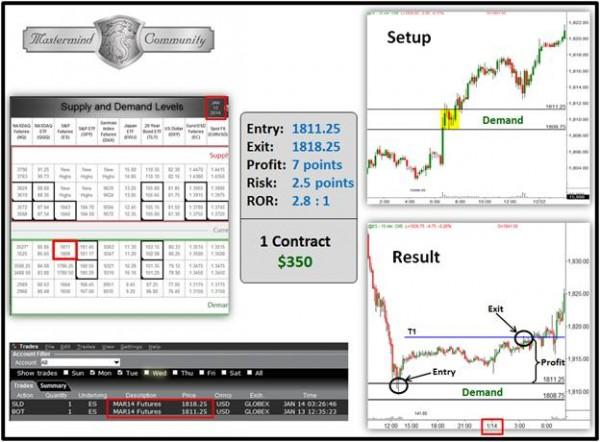![]()
Supply and demand is not a new concept. Adam Smith wrote of it extensively in many of his publications including his prized work entitled; “The Wealth of Nations”. There are many theories regarding how, and what effects supply and demand. The entire goal of this quest is to figure out where price is going. Just watch a few minutes of CNBC, Fox Business, CNN Money, Bloomberg, or just about any other news outlet in the morning and you will likely hear just enough theories, opinions on what’s influencing the financial markets to become very confused. Most of us would agree that in any market, the movement of price is simply a function of an ongoing supply and demand equation. Where everybody differs in opinion is the question of what is affecting supply and demand, and this also happens to be what everyone focuses on. This is talk that dominates financial news channels 24/7 around the world – talk of interest rates, the latest issue in the Middle East, what’s the whisper number for Google this quarter, and so on. Smart phones run out of battery life trying to keep up with all the economic data coming through. Again, focus on all these influences on supply and demand is to attempt to determine where price is going to turn and where it is going to go. What I do decidedly different than most is simply ignore all those influences. I mean I literally ignore any and all of the news, data, and information that has an influence on supply and demand. 100% of my focus is on one thing, the actual supply and demand itself. Why do I care about reasons people, banks, and financial institutions are buying and selling if I have a very good idea where they are buying and selling? Price changes direction at price levels where supply and demand are out of balance, so my focus is identifying the supply and demand imbalance itself, not trying to figure out the latest scandal in Cyprus. Even if I did spend some time dissecting Europe’s balance sheet, I would end up with the same information millions of other people already have so there would be no edge for me.
Specifically, I am focused on where big institutions are buying and selling in markets. Many people will say that is not even remotely possible. If you are in that camp, that is ok, this is what makes a market. Truth is you can identify where the smart money is buying and selling in markets if you know how to identify and quantify demand and supply on a price chart.
Let’s take a look at a recent short term income buying opportunity we had in the S&P. The supply/demand grid you see below is found in the Mastermind Community at Online Trading Academy. It is one of many tools and resources used by our members. The first row (top demand row and bottom supply row) are levels found for short term income trading opportunities. The second and third rows are levels to be used for longer term wealth opportunities (larger supply/demand imbalances, larger profit targets).
S&P Demand – 1/13/14Our supply/demand grid had a short term income demand level in the S&P at 1808 – 1811 which is where we want to buy. As you can see from the grid, the nearest significant supply level was at 1840 so there was room for the price to rally from our demand zone.
After the market got going, price fell into our predetermined demand level where our students were instructed to buy. How did we know banks were buying at that level, creating the demand? Look at the demand level shaded yellow. It is demand because price rallied from that level as I write about in so many of my articles. Think about this… Do you or anyone you know have an account size to cause a demand level like that in the S&P? Probably not, so… if it is not your demand, whose demand is it? It is the picture that represents where the smart money is buying, our odds enhancers tell us this. That is where they are buying, that is where we want to buy. I do not care about why they are buying there at all. Why would that matter?
We just predetermined where the low of the day was in the largest equity index markets in the world this is long before the market even opened. We did not have to consider ANYTHING that had to do with economic reports, balance sheets, Greece, earnings reports, or any of that stuff… In other words, we spent 0% of our time focused on what almost everyone else spends 100% of their time focused on to answer the same question. That demand level ended up producing the low of the week for the S&P which is when we bought.

I started my career on the floor of the Chicago Mercantile Exchange facilitating institutional order flow. Therefore, I know what the picture of a exceptionally smart money demand and supply looks like on a price chart. The more you understand how to quantify demand and supply in any and all markets, the less you need to focus on anything else. The point of this piece is to make sure you are focused on the right information when building your trading strategy. If not, you may find one day that you have figured out everything there is to know about economic reports only to realize that this will not help you make money speculating in the financial markets. Instead of asking what the financial reports and numbers suggest to determine where price is going to go… Skip the first part and ask yourself where price is going to go and understand the only thing that causes price to turn and move in markets is pure supply and demand.
Lastly, the trade above is from one of our newer students and it was her very first live, real money trade after lots of hard work and practice. She is a regular reader of Lesson’s From The Pro’s. Great job on your first trade!
I hope this was helpful. Have a great day.
Note: All information on this page is subject to change. The use of this website constitutes acceptance of our user agreement. Please read our privacy policy and legal disclaimer. Opinions expressed at FXstreet.com are those of the individual authors and do not necessarily represent the opinion of FXstreet.com or its management. Risk Disclosure: Trading foreign exchange on margin carries a high level of risk, and may not be suitable for all investors. The high degree of leverage can work against you as well as for you. Before deciding to invest in foreign exchange you should carefully consider your investment objectives, level of experience, and risk appetite. The possibility exists that you could sustain a loss of some or all of your initial investment and therefore you should not invest money that you cannot afford to lose. You should be aware of all the risks associated with foreign exchange trading, and seek advice from an independent financial advisor if you have any doubts.
Editors’ Picks
EUR/USD clings to gains above 1.0750 after US data

EUR/USD manages to hold in positive territory above 1.0750 despite retreating from the fresh multi-week high it set above 1.0800 earlier in the day. The US Dollar struggles to find demand following the weaker-than-expected NFP data.
GBP/USD declines below 1.2550 following NFP-inspired upsurge

GBP/USD struggles to preserve its bullish momentum and trades below 1.2550 in the American session. Earlier in the day, the disappointing April jobs report from the US triggered a USD selloff and allowed the pair to reach multi-week highs above 1.2600.
Gold struggles to hold above $2,300 despite falling US yields

Gold stays on the back foot below $2,300 in the American session on Friday. The benchmark 10-year US Treasury bond yield stays in negative territory below 4.6% after weak US data but the improving risk mood doesn't allow XAU/USD to gain traction.
Bitcoin Weekly Forecast: Should you buy BTC here? Premium

Bitcoin (BTC) price shows signs of a potential reversal but lacks confirmation, which has divided the investor community into two – those who are buying the dips and those who are expecting a further correction.
Week ahead – BoE and RBA decisions headline a calm week

Bank of England meets on Thursday, unlikely to signal rate cuts. Reserve Bank of Australia could maintain a higher-for-longer stance. Elsewhere, Bank of Japan releases summary of opinions.
RECOMMENDED LESSONS
Making money in forex is easy if you know how the bankers trade!
Discover how to make money in forex is easy if you know how the bankers trade!
5 Forex News Events You Need To Know
In the fast moving world of currency markets, it is extremely important for new traders to know the list of important forex news...
Top 10 Chart Patterns Every Trader Should Know
Chart patterns are one of the most effective trading tools for a trader. They are pure price-action, and form on the basis of underlying buying and...
7 Ways to Avoid Forex Scams
The forex industry is recently seeing more and more scams. Here are 7 ways to avoid losing your money in such scams: Forex scams are becoming frequent. Michael Greenberg reports on luxurious expenses, including a submarine bought from the money taken from forex traders. Here’s another report of a forex fraud. So, how can we avoid falling in such forex scams?
What Are the 10 Fatal Mistakes Traders Make
Trading is exciting. Trading is hard. Trading is extremely hard. Some say that it takes more than 10,000 hours to master. Others believe that trading is the way to quick riches. They might be both wrong. What is important to know that no matter how experienced you are, mistakes will be part of the trading process.

